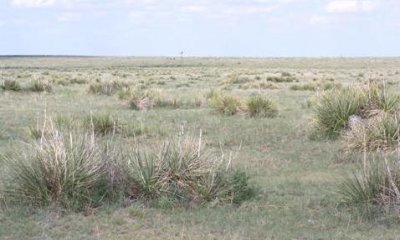
Limy Upland 12-17" PZ
Scenario model
Current ecosystem state
Select a state
Management practices/drivers
Select a transition or restoration pathway
-
Transition T1A
Absence of disturbance and natural regeneration over time, may be coupled with excessive grazing pressure
More details -
Restoration pathway R2A
Adequate rest from defoliation and removal of woody canopy, followed by reintroduction of historic disturbance regimes
More details -
Transition T2A
Absence of disturbance and natural regeneration over time, may be coupled with excessive grazing pressure
More details -
Restoration pathway R3B
Adequate rest from defoliation and removal of woody canopy, followed by reintroduction of historic disturbance regimes
More details -
Restoration pathway R3A
Adequate rest from defoliation and removal of woody canopy
More details -
No transition or restoration pathway between the selected states has been described
Target ecosystem state
Select a state
State 1
Shortgrass/Midgrass State



Description
The reference plant community for this site was a Shortgrass/Midgrass Community (1.1) with few tallgrasses. There was a good variety of perennial forbs with a few scattered woody shrubs consisted of yucca, catclaw mimosa, plains pricklypear, broom snakeweed, and cholla. The calcareous soils influenced the species composition of the site. Productivity is moderate with most of the production coming from sideoats grama and blue grama. Other commonly found grasses were buffalograss, sand dropseed and perennial threeawn. Vine mesquite and western wheatgrass could be found in runoff concentration areas. The more free lime there is in the soil, the higher the sideoats grama and little bluestem composition.
If excessive grazing continues for long periods of time, ecologic retrogression occurs. As retrogression proceeds, this site will move towards the Shortgrass/Midgrass/Shrub Community (1.2) with an increase in woody and annual plants. The low vigor midgrasses will decrease and the shortgrass species such as blue grama, perennial threeawn and annuals will increase to the point of dominating the site. Shrubs such as yucca and possibly broom snakeweed will become a significant part of the plant community. Plant composition will be less diverse than the reference community.
Submodel
Description
The Shortgrass/Shrub State has experienced increasing shrubs, annuals and perennial three-awns. There are minimal midgrasses present in this community. The plant populations have low vigor, low production, and increase in bare ground.
Submodel
Description
This State has low vigor shortgrasses and no midgrasses remaining on the site. There is a low annual production potential with this plant community. The shrubs are dominating the site tremendously. There is also a high percentage (50+ percent) of bare ground.
Submodel
Mechanism
The Shortgrass/Midgrass State will transition to the Shortgrass/Shrub State due to heavy continuous grazing, no fire, no brush management, brush invasion, and no pest management.
Mechanism
With the implementation of various conservation practices such as Prescribed Grazing, Brush Management, Pest Management, and Range Planting, the Shortgrass/Shrub Community can be reverted back to the Shortgrass/Midgrass State.
Relevant conservation practices
| Practice | External resources |
|---|---|
|
Brush Management |
|
|
Prescribed Grazing |
|
|
Range Planting |
|
|
Integrated Pest Management (IPM) |
Mechanism
Heavy continuous grazing, no brush management, no pest management, and no fires have lead to a transition from a Shortgrass/Shrub State to a Shrub/Shortgrass State.
Mechanism
When Prescribed Grazing, Brush Management, Pest Management, and Range Planting conservation practices are implemented, the Shrub/Shortgrass Community can be restored to the Shortgrass/Midgrass State.
Relevant conservation practices
| Practice | External resources |
|---|---|
|
Brush Management |
|
|
Prescribed Grazing |
|
|
Range Planting |
|
|
Integrated Pest Management (IPM) |
Mechanism
With the implementation of various conservation practices such as Prescribed Grazing, Brush Management, Pest Management, and Range Planting, the Shrub/Shortgrass Community can be restored to the Shortgrass/Shrub Community.
Relevant conservation practices
| Practice | External resources |
|---|---|
|
Brush Management |
|
|
Prescribed Grazing |
|
|
Range Planting |
|
|
Integrated Pest Management (IPM) |
Model keys
Briefcase
Add ecological sites and Major Land Resource Areas to your briefcase by clicking on the briefcase (![]() ) icon wherever it occurs. Drag and drop items to reorder. Cookies are used to store briefcase items between browsing sessions. Because of this, the number of items that can be added to your briefcase is limited, and briefcase items added on one device and browser cannot be accessed from another device or browser. Users who do not wish to place cookies on their devices should not use the briefcase tool. Briefcase cookies serve no other purpose than described here and are deleted whenever browsing history is cleared.
) icon wherever it occurs. Drag and drop items to reorder. Cookies are used to store briefcase items between browsing sessions. Because of this, the number of items that can be added to your briefcase is limited, and briefcase items added on one device and browser cannot be accessed from another device or browser. Users who do not wish to place cookies on their devices should not use the briefcase tool. Briefcase cookies serve no other purpose than described here and are deleted whenever browsing history is cleared.
Ecological sites
Major Land Resource Areas
The Ecosystem Dynamics Interpretive Tool is an information system framework developed by the USDA-ARS Jornada Experimental Range, USDA Natural Resources Conservation Service, and New Mexico State University.




